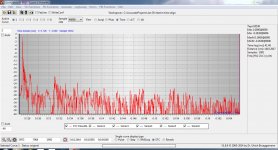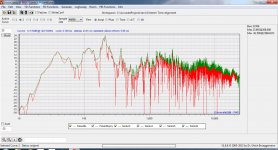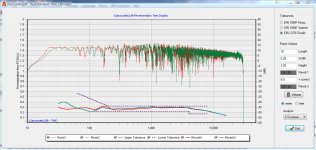With a good passive treatment and, provided the room is big enough to place and listen to them properly, you would not need any subwoofer to get the real bass. No matter what frequency response of those Nathan's says.
How so? What is "the real bass"?
Time domain is more important to the listener than the frequency domain. They are not equivalent for him. You should know....
Why should I know that? All I know is that both is important, time and frequency response.
How so? What is "the real bass"?
Why should I know that? All I know is that both is important, time and frequency response.
The real bass is what is in the recording. The room gain can only add SPL but not necessarily information. You don't get it fully if the direct signal is too much corrupted. Your brain will simply bin part of the information it carries it because it is not congruent with his " real world reference" and expectation.
I was supposing you know because you seem to read a lot and that can be understood from what serious research about human beings has found out.
^
The room represents a filter that changes spatially. So there will never be "the real bass". Adding an additional filter to the original signal can improve the situation though.
The room represents a filter that changes spatially. So there will never be "the real bass". Adding an additional filter to the original signal can improve the situation though.
There can be most of it. Perfection does not belong to our world. Equalization is not a substitute for passive treatment of the room. If you give it a go you won't regret it.
The superposition of effects due to "two different rooms" doesn't apply to humans whose brain rather works in differential mode. If something is not congruent to his expectations it will be discarded and not taken in some way like the microphone does. It is the method that is not congruent in the first place, unfortunately.
The superposition of effects due to "two different rooms" doesn't apply to humans whose brain rather works in differential mode. If something is not congruent to his expectations it will be discarded and not taken in some way like the microphone does. It is the method that is not congruent in the first place, unfortunately.
There can be most of it. Perfection does not belong to our world. Equalization is not a substitute for passive treatment of the room. If you give it a go you won't regret it.
This thread is not about acoustic treatments vs. equalization. It's solely about the latter. It's even limited to PEQ.
The superposition of effects due to "two different rooms" doesn't apply to humans whose brain rather works in differential mode. If something is not congruent to his expectations it will be discarded and not taken in some way like the microphone does. It is the method that is not congruent in the first place, unfortunately.
Let's take common (re)production practices as a given and not turn this into a debate about stereo in general.
This thread is not about acoustic treatments vs. equalization. It's solely about the latter. It's even limited to PEQ.
Let's take common (re)production practices as a given and not turn this into a debate about stereo in general.
Ok. Bye.
re: holm impulse and rephase - no I have not tried, had a close look, but could not find any information on whether these tools applied a psychoacoustic calculation like Acourate does (see attached). As mentioned previously, this I believe what makes Acourate unique.
Speaking of psychoacoustics, as linked before, folks should read JJ Johnston's research on why we hear what we hear. Then read his presentation on room correction: http://www.aes.org/sections/pnw/ppt/jj/room_correction.ppt
The so called house curves mentioned are designed to provide the listener with a *perceptually* flat frequency response at the listening position independent of room and speakers. Again, understanding pyschoacosutics from JJ's articles helps understanding why this is.
For example, one person I know shares the same target frequency response as I, but our rooms and speakers are completely different. So when I remark on a tune and say this one is mixed/mastered a bit bright, the other person has the same consensus, even though the other person has completely different speakers and listening environment.
The assumption is that the listening room already has been treated appropriately to take care of first reflections points (floor ceiling, side walls, etc.) and that enough bass trapping, diffusion/absorption has been applied for a nice even decay over all frequencies.
The rule of thumb is that early room reflections should be -20 dB or lower than the main pulse for this first 0 to 40 ms of sound travel in the room. See attached ETC of my room that just meets this requirement.
Attached is the RT60 of my room that meets the EBU 3276 guidelines (also attached). While the EBU 3276 tech guidelines are a bit old, it really is a good read and also has another house curve 🙂 very similar to what we are discussing hear. There is a reason for that.
As an ex recording/mixing engineer, my worst nightmare is spending weeks in one recording studio, then move to another and find everything sounds different. Has happened to me. So which control room had the right sound? That's why we have standards. That's why when I say to my friend, hey this tune sounds like it has been mixed/mastered a bit bright and my friend hears the same on his calibrated system, even though his speakers and room are completely different.
Tip on fine tuning one's target response by ear. Use any one of the target responses mentioned in this thread as all of them will be in the ball park to provide a perceptually flat frequency response at the listening position.
Then, from your music collection, select what you hear as the brightest mixed/mastered song you have and then select the dullest or least brightest song. Then play both using the target response. Then fine tune the target by moving the 20 kHz end point up or down 1, 2 or 3 dB, using the recommended 1 kHz hinge point, and listen again. It won't take long to strike the optimum balance between too bright and too dull and still be within the tolerances of any of these target response curves posted in this thread. One is calibrating their system to a known standard. That's the point.
Like I say, I have not changed my target response in almost a year and I listen to my system for hours each day with music content, movies, radio, etc., with no need to make any further adjustments. My target is flat to 1 kHz, hinging at 1 kHz, and straight line to -7 dB at 20 kHz. This is 1 dB less then the -6 dB target as my room is still a wee bit bright as seen in the RT60, even though it falls within the guidelines (I am very picky).
For me, as an ex recording/mixing engineer, I want a *calibrated* system so I am hearing as accurately as possible what the mixing and mastering engineers, producers, and recording artists heard at the studio. These folks laboriously went over each track, sometimes 100's of times, to mix and master the sound for our listening enjoyment. That's what I want to hear as accurately as possible. Cheers, Mitch
Speaking of psychoacoustics, as linked before, folks should read JJ Johnston's research on why we hear what we hear. Then read his presentation on room correction: http://www.aes.org/sections/pnw/ppt/jj/room_correction.ppt
The so called house curves mentioned are designed to provide the listener with a *perceptually* flat frequency response at the listening position independent of room and speakers. Again, understanding pyschoacosutics from JJ's articles helps understanding why this is.
For example, one person I know shares the same target frequency response as I, but our rooms and speakers are completely different. So when I remark on a tune and say this one is mixed/mastered a bit bright, the other person has the same consensus, even though the other person has completely different speakers and listening environment.
The assumption is that the listening room already has been treated appropriately to take care of first reflections points (floor ceiling, side walls, etc.) and that enough bass trapping, diffusion/absorption has been applied for a nice even decay over all frequencies.
The rule of thumb is that early room reflections should be -20 dB or lower than the main pulse for this first 0 to 40 ms of sound travel in the room. See attached ETC of my room that just meets this requirement.
Attached is the RT60 of my room that meets the EBU 3276 guidelines (also attached). While the EBU 3276 tech guidelines are a bit old, it really is a good read and also has another house curve 🙂 very similar to what we are discussing hear. There is a reason for that.
As an ex recording/mixing engineer, my worst nightmare is spending weeks in one recording studio, then move to another and find everything sounds different. Has happened to me. So which control room had the right sound? That's why we have standards. That's why when I say to my friend, hey this tune sounds like it has been mixed/mastered a bit bright and my friend hears the same on his calibrated system, even though his speakers and room are completely different.
Tip on fine tuning one's target response by ear. Use any one of the target responses mentioned in this thread as all of them will be in the ball park to provide a perceptually flat frequency response at the listening position.
Then, from your music collection, select what you hear as the brightest mixed/mastered song you have and then select the dullest or least brightest song. Then play both using the target response. Then fine tune the target by moving the 20 kHz end point up or down 1, 2 or 3 dB, using the recommended 1 kHz hinge point, and listen again. It won't take long to strike the optimum balance between too bright and too dull and still be within the tolerances of any of these target response curves posted in this thread. One is calibrating their system to a known standard. That's the point.
Like I say, I have not changed my target response in almost a year and I listen to my system for hours each day with music content, movies, radio, etc., with no need to make any further adjustments. My target is flat to 1 kHz, hinging at 1 kHz, and straight line to -7 dB at 20 kHz. This is 1 dB less then the -6 dB target as my room is still a wee bit bright as seen in the RT60, even though it falls within the guidelines (I am very picky).
For me, as an ex recording/mixing engineer, I want a *calibrated* system so I am hearing as accurately as possible what the mixing and mastering engineers, producers, and recording artists heard at the studio. These folks laboriously went over each track, sometimes 100's of times, to mix and master the sound for our listening enjoyment. That's what I want to hear as accurately as possible. Cheers, Mitch
Attachments
Mostly guesswork 🙄
For instance: Torsten Dau shows in Modeling auditory evoked brainstem responses to transient stimuli page 14-17 that tone bursts of 5-10 cycles excite nerve pulses from the equivalent parts of the basiliar membrane. That's just one part of my guesswork. 😉
Not really related but here's an example how many repetitions are necessary to produce the sensation of pitch:
How many repetitions are required to produce pitch? | Auditory Neuroscience
Last edited:
Not really related but here's an example how many repetitions are necessary to produce the sensation of pitch:
How many repetitions are required to produce pitch? | Auditory Neuroscience
Do you have any idea how many repetitions are necessary at low frequencies? I remember to have read an article once that said that at low frequencies a couple of repetitions were necessary not only to hear a pitch, but to perceive the sound at all. If this is true, waterfalls may not correlate with what we hear as well as do simple steady-state response measurements.
^
This would explain why EQ works exceptionally well at low frequencies. Waterfalls would still be meaningful.
Currently reading "Auditory Neuroscience - Making Sense of Sound". Guess when I'm finished I know the answer - not 😉
This would explain why EQ works exceptionally well at low frequencies. Waterfalls would still be meaningful.
Currently reading "Auditory Neuroscience - Making Sense of Sound". Guess when I'm finished I know the answer - not 😉
Last edited:
Yes - because they show a tail length that is proportional to the Q of a resonance independent of frequency.Well, that's a reason why there are period-based decay graphs.
Doesn't necessary say anything about how our hearing works though.
This thread is not about acoustic treatments vs. equalization. It's solely about the latter. It's even limited to PEQ.
Shall we remain within the confinement (coffin) of parametric equalization Markus?
Like what's inside the Emotiva UMC-2 SSP for example?
Acourate, Dirac Live, Datasat, Trinnov, JBL Synthesis, Audyssey, Room Perfect, etc.; we shouldn't include any of them in this discussion?
____________________
There are parametric EQs, and then there are parametric EQs.
Hi guys,
With the availability of cheap and good quality parametric EQs I was wondering if they can be used for room/speaker correction.
I'd like to hear everybody's thoughts on the topic. How can PEQs improve reproduction? Can we improve only a single point or even multiple points? What measurements need to be taken? How do we correlate them to what we hear? How to apply PEQs to mixed-phase responses? Etc. pp.
@Mods: Hope this topic can stay in "Multi-Way" because of visibility and its close relationship to the speaker/room interface.
Here's my answer.

Shall we remain within the confinement (coffin) of parametric equalization Markus?
Like what's inside the Emotiva UMC-2 SSP for example?
Sorry, I meant the Emotiva UMC-200.
________________
An expert with parametric equalizers, like for home theater rooms for example, can he do a good job for all the seats in that room, like say nine (9) listener seats?
- Can he make the low bass frequencies correct for everyone?
- About the mids and highs?
What final tool does he bases his final settings/results on; measurements or listening sessions? ...Or an average of both?
Multiple subwoofers, dual center channel speakers, all the various crossovers, low-pass and high-pass filters, phases between the subs and the mains, various listening positions, ... how does he do it at the end?
Raising which, lowering what, extending the "Q" to where, shortening the "Q" to where, which audio frequencies they usually 'play' with, and which ones they try best to avoid?
Any scientific papers on effective results for a specifically determined room's size and listener's positions?
...And always using only parametric equalizers.
Shall we remain within the confinement (coffin) of parametric equalization Markus?
Like what's inside the Emotiva UMC-2 SSP for example?
Exactly the reason why I've limited the topic. Mixed phase EQ isn't available to the masses. There is no multichannel convolution box. PEQ on the other hand is everywhere (miniDSP, DCX2496, UMC-200, ...).
PEQ means minimum phase filters. We even haven't touched that topic yet.
Alright.
Now, stereo and/or multichannel; I guess it don't matter, except that for multichannel (eg.; 2.1, 3.0, 4.0, 5.0, 5.1, 6.0, 7.1, 9.3, 11.4-ch., ...) it gets more complex with the phase issue, and the overall result from all the channels singing in unison and heard @ the sweet spot in the room.
A parametric EQ has determined frequency spots from the audio spectrum, and where you can add or deduct the level in dB, and with the "Q" adjustable at each particular audio frequency (wider or narrower).
Some are 1/3 Octave PEQs, others 1/6 Octave, 1/10th, 1/30th, ...
"PEQ means minimum phase philters." ...Minimum, or quasi nil?
Now, stereo and/or multichannel; I guess it don't matter, except that for multichannel (eg.; 2.1, 3.0, 4.0, 5.0, 5.1, 6.0, 7.1, 9.3, 11.4-ch., ...) it gets more complex with the phase issue, and the overall result from all the channels singing in unison and heard @ the sweet spot in the room.
A parametric EQ has determined frequency spots from the audio spectrum, and where you can add or deduct the level in dB, and with the "Q" adjustable at each particular audio frequency (wider or narrower).
Some are 1/3 Octave PEQs, others 1/6 Octave, 1/10th, 1/30th, ...
"PEQ means minimum phase philters." ...Minimum, or quasi nil?
- Status
- Not open for further replies.
- Home
- General Interest
- Room Acoustics & Mods
- Room Correction with PEQ


